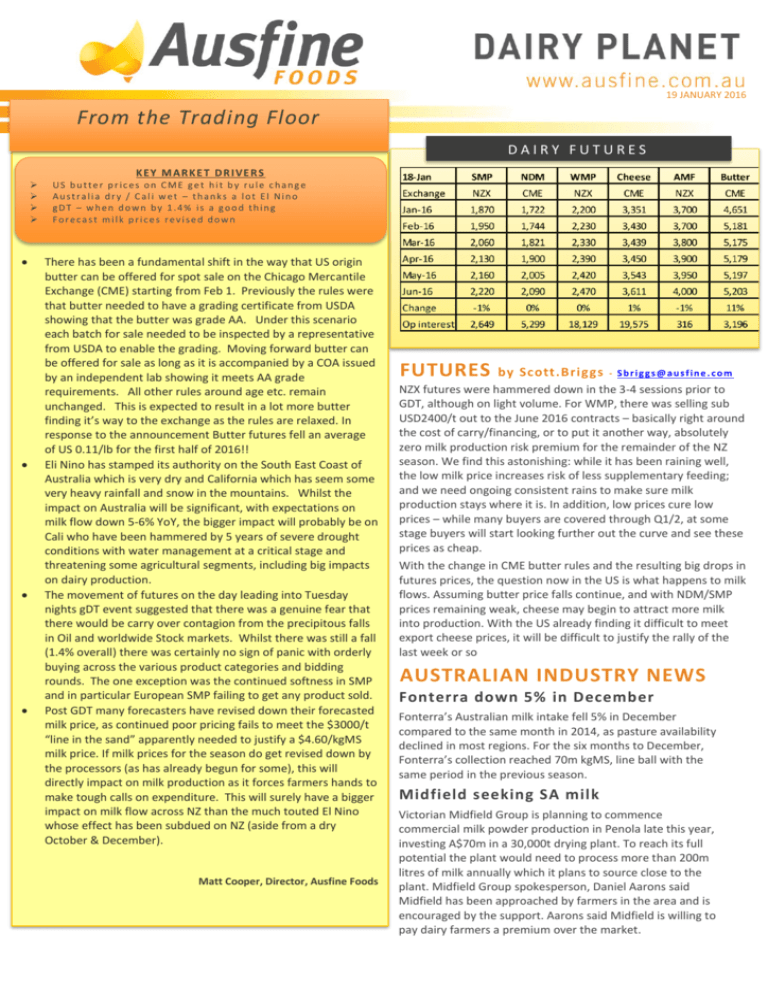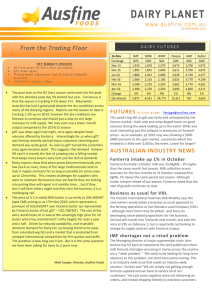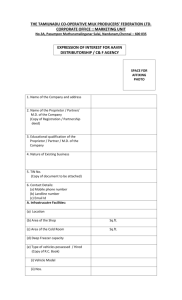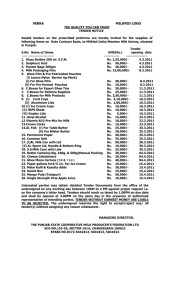From the Trading Floor
advertisement

19 JANUARY 2016 From the Trading Floor Sfd DAIRY FUTURES KEY MARKET DRIVERS US butter prices on CME get hit by rule change Australia dry / Cali wet – thanks a lot El Nino gDT – when down by 1.4% is a good thing Forecast milk prices revised down There has been a fundamental shift in the way that US origin butter can be offered for spot sale on the Chicago Mercantile Exchange (CME) starting from Feb 1. Previously the rules were that butter needed to have a grading certificate from USDA showing that the butter was grade AA. Under this scenario each batch for sale needed to be inspected by a representative from USDA to enable the grading. Moving forward butter can be offered for sale as long as it is accompanied by a COA issued by an independent lab showing it meets AA grade requirements. All other rules around age etc. remain unchanged. This is expected to result in a lot more butter finding it’s way to the exchange as the rules are relaxed. In response to the announcement Butter futures fell an average of US 0.11/lb for the first half of 2016!! Eli Nino has stamped its authority on the South East Coast of Australia which is very dry and California which has seem some very heavy rainfall and snow in the mountains. Whilst the impact on Australia will be significant, with expectations on milk flow down 5-6% YoY, the bigger impact will probably be on Cali who have been hammered by 5 years of severe drought conditions with water management at a critical stage and threatening some agricultural segments, including big impacts on dairy production. The movement of futures on the day leading into Tuesday nights gDT event suggested that there was a genuine fear that there would be carry over contagion from the precipitous falls in Oil and worldwide Stock markets. Whilst there was still a fall (1.4% overall) there was certainly no sign of panic with orderly buying across the various product categories and bidding rounds. The one exception was the continued softness in SMP FROM PHILIPPINES and in particular European SMP failing to get any product sold. Post GDT many forecasters have revised down their forecasted milk price, as continued poor pricing fails to meet the $3000/t “line in the sand” apparently needed to justify a $4.60/kgMS milk price. If milk prices for the season do get revised down by the processors (as has already begun for some), this will directly impact on milk production as it forces farmers hands to make tough calls on expenditure. This will surely have a bigger impact on milk flow across NZ than the much touted El Nino whose effect has been subdued on NZ (aside from a dry October & December). Matt Cooper, Director, Ausfine Foods FUTURES by Scott.Briggs - Sbriggs@ausfine.com NZX futures were hammered down in the 3-4 sessions prior to GDT, although on light volume. For WMP, there was selling sub USD2400/t out to the June 2016 contracts – basically right around the cost of carry/financing, or to put it another way, absolutely zero milk production risk premium for the remainder of the NZ season. We find this astonishing: while it has been raining well, the low milk price increases risk of less supplementary feeding; and we need ongoing consistent rains to make sure milk production stays where it is. In addition, low prices cure low prices – while many buyers are covered through Q1/2, at some stage buyers will start looking further out the curve and see these prices as cheap. With the change in CME butter rules and the resulting big drops in futures prices, the question now in the US is what happens to milk flows. Assuming butter price falls continue, and with NDM/SMP prices remaining weak, cheese may begin to attract more milk into production. With the US already finding it difficult to meet export cheese prices, it will be difficult to justify the rally of the last week or so AUSTRALIAN INDUSTRY NEWS Fonterra down 5% in December Fonterra’s Australian milk intake fell 5% in December compared to the same month in 2014, as pasture availability declined in most regions. For the six months to December, Fonterra’s collection reached 70m kgMS, line ball with the same period in the previous season. Midfield seeking SA milk Victorian Midfield Group is planning to commence commercial milk powder production in Penola late this year, investing A$70m in a 30,000t drying plant. To reach its full potential the plant would need to process more than 200m litres of milk annually which it plans to source close to the plant. Midfield Group spokesperson, Daniel Aarons said Midfield has been approached by farmers in the area and is encouraged by the support. Aarons said Midfield is willing to pay dairy farmers a premium over the market. GLOBAL DAIRY MARKETS Aussie parents get first dibs Blackmore and Bega’s high-quality baby formula is set to hit the shelves this month as the companies have stocked 100,000 cans in pharmacies across Australia. 80% of the formula will be sold domestically with the remainder of the going to pharmacies and partner retailers in Asia. According to Blackmore CEO Christine Holgate, catering for the Australian market first reflects local needs, and the fact that the company’s success in Asia is due to its success in Australia. week were lost. Roller Coaster rides here to stay for foreseeable future. Weather highlights In Australia, brisk southerlies are bringing showers to the Vic and NSW coast over the weekend. Troughs deepening in the west will spread showers and storms with a high keeping western Vic dry. In NZ, some much needed rain is forecast over the Islands. In the North Island isolated showers in Northland. Rain in the West of the South Island, with possible heavy falls. In the US, a major snowstorm to sweep across eastern US, with the possibility of snow and rain. Coastal California is expecting rain. Dry and hot weather across southern and central Brazil, rain in the north; dry across northern regions of Argentina. Freezing temperatures across eastern parts of Europe and Scandinavia, while the rest of the continent slowly thaws. Fonterra’s milk collection down Fonterra suffered a 2.8% decline in milk collection for December compared to the same month in 2014. In the North Island, 118m kgMS was collected for the month, 6% lower than December 2014. At 77m kgMS the South Island was 1% down for the month. For the season to 31 December a total of 932m kgMS has been collected, down 4% on the same period in 2014, reflecting a low milk price that has encouraged farmers to reduce stocking rates and supplementary feeding to reduce costs. CME Butter pricing very volatile CME butter prices rose sharply over the past week, despite local analysts expecting downward pressure in Q1-2016. Futures for February to June 2016 delivery increased between 13.1% and 13.5% relative to the prior week, with the January 2016 contract up 3.2% at $US4,651/t. According to leading analysts Jerry Dryer and Matthew Gould, the price increase “was caused in part by sudden purchasing.” The winter storm Goliath represents a relatively significant supply-side shock, reducing the January 2016 US butter output by as much as 3% based on some estimates, in an already undersupplied market. Due to rule changes regarding butter grading February through June contracts were trading down US$220/t relative to Friday’s settle price. The decision to relax the rules around eligibility on CME butter hit the market and all the gains from the previous 2 EU milk output still going strong EU-28 milk output increased 5.5% in November relative to the same month in 2014, according to Eurostat, showing that France as the only major producer behind in comparative terms against last year. In Ireland (up 48%) and Netherlands (up close to 14%) output continues to surge through this seasonally low period, a major worry for processors attempting to manage milk flows. Preliminary December data points to continued strong growth. Netherlands milk intake is up 16.6% YOY, while German output was also 4.1% higher in the last week of December relative to the same period in 2014. French milk production however, appears to be slowing, up just 0.4% YOY in week 53. GDT edges lower The GDT price index fell 1.4% this week, following the negative result from the first auction in the new year. This week, the AMF index increased by 2.4% (to US$3,724/t) while WMP and SMP indices decreased by 0.5% (to US$2,188/t) and 3.2% (to US$1,835/t), respectively. In the case of WMP, after a 3.2% fall in the contract 1 price, values improved this auction, up 9.1% by contract 6. The butter index plummeted 5.9% (to US$3,162/t).







